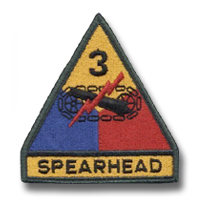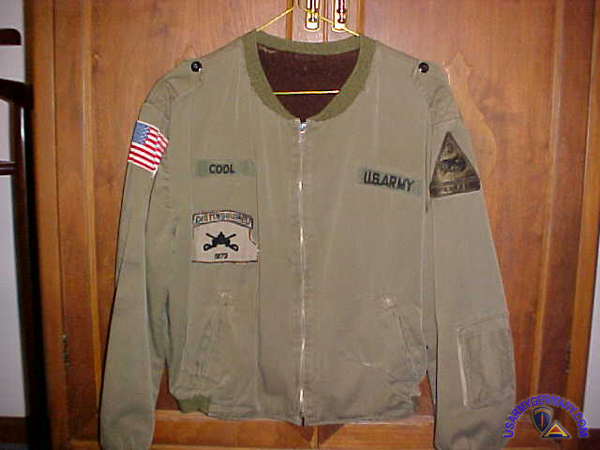If you do NOT see the Table of Contents frame to the left of this page, then
Click here to open 'USArmyGermany' frameset |
3rd Armored Division
(Page 2 - Combat Commands / Brigades)
Looking for more information from military/civilian
personnel assigned to or associated with the U.S. Army
in Germany from 1945 to 1989. If you have any
stories or thoughts on the subject, please contact me . .
|
|
|
|
|
|
| Combat Command "A" / 1st Brigade |
| |
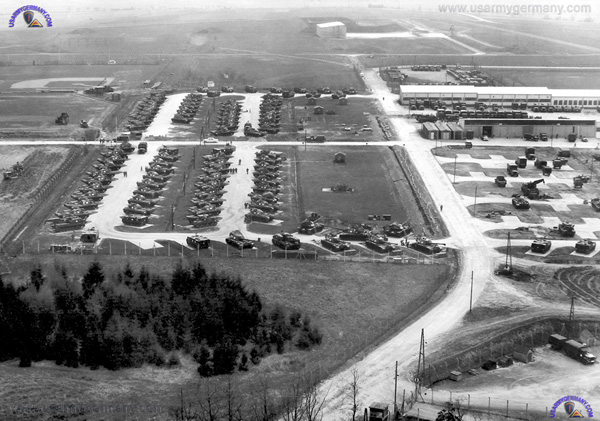
[A] Aerial of Ayers Kaserne, Kirch-Göns, 1959 (Alain Dailloux) |
| |

Aerial of Ayers Kaserne, Kirch-Göns, 1959 (Alain Dailloux) |
| |
| 1959 |
| (Source: Email from Hank Johnson, son of Lawrence H. Johnson, Jr. former CO of A Company, 709th Tank Bn/2nd Bn-13th Cav) |
Very nice surprise, to do my weekly "look see" of your site; and find the new Kirch Goens photos. Just so happens.... my father commanded A Co, 2d Med Tk Bn, 13th Cavalry from 1957-59.
When my dad first took command, in the spring of 1957, the unit was designated A Co, 709th Tank Bn. In Oct of 1957 (with the advent of CARS), the 709th Tk was re-flagged as 2/13 Cav.
The first new aerial photo [A] shows the 2/13 Cav motor pool area at KG. As a kid, my dad used to take me there, quite often, and it brought back many memories. When my dad first took command, A Co was on the fence line (far left) and from left to right would have been A, B, C and D Co. Later, the companies were reversed - from the fence - D, C, B, A. |
|
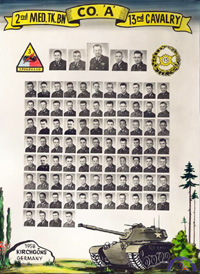 Company Photo
Company Photo |
|
The M-103s belonged to a company of the 899th Heavy Tk Bn, out of Hanau. Can't remember which company it was, but I know it was commanded by my father's friend, Don Valeska. In Oct 1957, the 899th became a battalion of the 33d Armor - I believe it was the 2nd Battalion?
The photo is definately post Oct 1957, as the M-48A1s sport the new geometric unit identifiers - in the case of 2/13 Cav - it was a yellow rectangle on the side of the turrets.
The second aerial photo [B] shows the motor pool for 2d MTB, 1st Cav (formerly the 7th Tk Bn). I think (?) I can see the unit identifier for 2/1 Cav (a yellow triangle) on the side of the turrets. |
|
Attached, two photos for A Co, 2/13 Cav. The first, a company photo for A-2/13 Cav, c fall 1958. That's my dad (Lawrence H. Johnson, Jr), at the top. He went on to command 7th Squadron (Air), 17th Cav - the division air cav squadron for the 4th Inf Div in the Central Highlands during the Vietnam War. During Tet 1968, under my dad's leadership, 7/17 Cav pounded the NVA flat (in the vicinity of Dak To and Kontum). The squadron was awarded 3 Presidential Unit Citations for that frenzied month. He retired in 1973, from the Joint Chiefs of Staff.
The second photo shows one of A Company's M-48A1s at Graf, c late spring '59.
I dug out my parents old, old address book. The 899th Hvy Tk Bn was an oddball unit, and it has taken me decades to come up with bits and pieces of information. The company of the 899th Hvy Tk Bn at Kirch Gons was B Co. With CARS in 1957, it became B Co, 2d Hvy Tk Bn, 33d Armor. It was a unit which was assigned to the 19th Armor Group (under CARS, redesignated the 4th Armor Group), but attached to the 3AD.
The 899th was equipped with the monstrous M-103 Heavy Tank. It was so heavy, it was most often road bound, but valued for its long-range 120mm gun. In other words, it was a "sniper tank", and as a result, the 899th (2/33 Armor) had its companies attached (OPCON) to divisions ringing the Fulda Gap. I do know that another of the companies was located at Aschaffenburg. |
|
| |
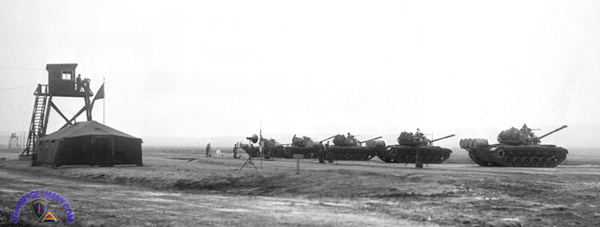 A Co, 2/13 Cav, Spring 1958 - Graf Table IV, known otherwise as Annual TCQC.
A Co, 2/13 Cav, Spring 1958 - Graf Table IV, known otherwise as Annual TCQC. |
| |
ADDITIONAL INFORMATION
We Gyroscoped w/3AD in Apr 1956 (our second tour to FRG). At that time, my dad commanded the 3d Armd Div Air Section at Bonames. We lived in the Drake-Edwards Housing area. I could see Camp King (and the Grosser Feldberg) from my bedroom window - a truly "million dollar view". All my dad ever told me - "That's where the weird intell stuff is.." lol.
After the 18 mos command time at KG, we went back to Drake-Edwards, where my dad was 3AD Asst G-2.
I truly love your site - I read it every week, and have for years. I can't thank you enough. I suffered a terrible mid-life crisis over the last 5-10 years; as the Germans began to tear down our old homes. I TRY to tell civilians (and they cannot comprehend) that most of my old "home towns" are now gone - obliterated. I try to tell them - 'Imagine, one night, you come back to the old 'hood. To your amazement, It's GONE!! Everything!! Church, stores, houeses, places of business." They still can't comprehend the emotions that are involved.
Our first tour (1949-53), my dad was fresh outta OCS (he had been an inf plat sgt w/103d ID in WWII). He was assigned to 1ID - first as the Pioneer and Ammo Plat Ldr of 16th Inf Regt. Then, in one of those weird career moves, so prevalent in the Old Army we all knew, was assigned as a tank plat ldr in Tk Co, 16th Inf Regt/1ID. He would eventually branch transfer to Armor and command Tk Co, 16th Inf Regt.
I've attached a couple of photos from the first tour. |
|
| |
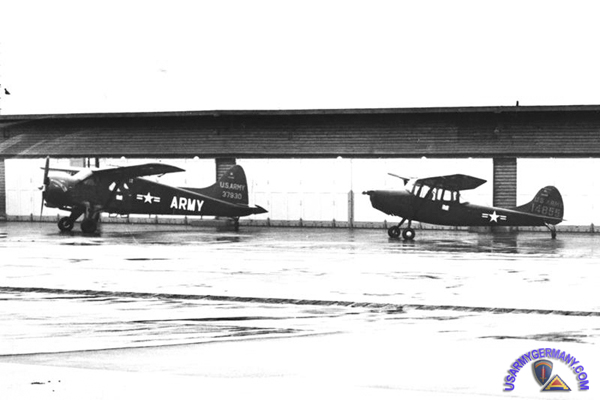 Aircraft of Aviation section, 3rd Armd Div at Bonames AAF, 1956
Aircraft of Aviation section, 3rd Armd Div at Bonames AAF, 1956 |
| |
| You have already posted this pic, under 503d Avn Bn (in the Aviation area). You show the whole photo. Thought you might like a little extra info, so I zoomed on the L-20 (left):
The photo is dated 7 Dec 1956 (not June 1956) and shows the 3d Armd Div Air Section (not avn det) aircraft, at that time stationed at Bonames. From 1955-1957, my dad commanded the Air Sect, and spent most of his time piloting the 3AD CG and senior staff around the Germany. The L-20 was his pride and joy - he had jazzed it up into a VIP aircraft - cavalry yellow rugs and wood-grain interior trim. The crowning glory was the nose art (which he designed), featuring a large cav yellow arrow and small lightning bolts. Superimposed on the large arrow was the division motto SPEARHEAD and the silhouette of an M-4A3E8 tank. EVERYBODY knew when Spearhead came to town. |
|
| |
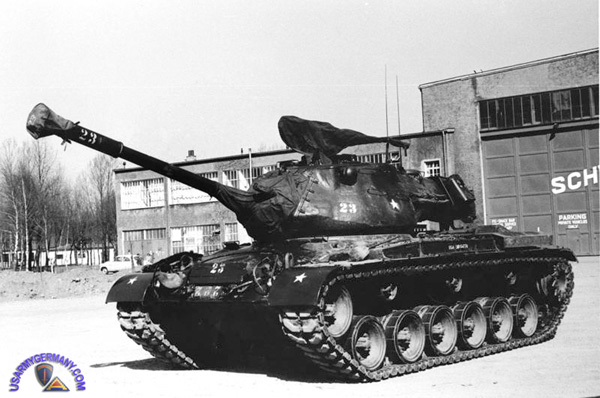
TK-23, Tk Co. Mar 1953. Tk Co has now moved to Schweinfurt and is equipped with the new M-47 tank. |
| |
FIRST TOUR -- 16TH INFANTRY REGIMENT, ASCHAFFENBURG
After being commissioned from OCS in 1949, my father was assigned to 2d Battalion, 16th Infantry Regiment at Pinder Barracks in Zirndorf. At that time, he was a Reserve officer, and the powers that be were quite blunt - "No RA, no line infantry platoon." As virtually every platoon leader in the regiment was RA, my father truly believed his Army career was over. He was dejected, but gladly accepted the Pioneer and Ammunition Platoon Leader slot.
At this point, his story becomes stranger than fiction. Everyone has seen the old version of the movie From Here To Eternity, and remembers the tremendous emphasis that high level commanders placed on regimental sports teams, during the 1930s - 1950s. Prior to being drafted in WWII, my father had played semi-pro baseball in rural Alabama. Somehow, that information reached 16th Infantry regimental HQ. One day, my father was shocked to see the regimental CO in his platoon area. The Regt CO wasted no time....... "Lieutenant, here's the deal. I understand you are a fine baseball player. If you will play on my 16th Infantry Regiment team, I will give you command of a line platoon." The deal was cut, in a nano second, but it turned out it wasn't quite what my father had expected. He would become a tank platoon leader, in Tank Company, 16th Inf Regt at Montieth Barracks in Furth (later Tank Co moved to Schweinfurt). Once again, dad thought his career was over - what would an infantry lieutenant do in a tank company? But he gave it his all, and it paid off, handsomely. Not only did the 16th Inf win the division baseball crown; but my father was so taken with tanks that he branch transferred to Armor. Before leaving Tank Company, the 1st Inf Div was sufficiently pleased with his performance, to grant him an RA commission and command of Tank Company. That simple decision to play baseball would send him on a long, long road, ending with retirement in 1973, as Colonel on the Joint Chiefs of Staff. |
|
2nd MTB, 13th Cav
Kirch-Goens |
|
|
|
|
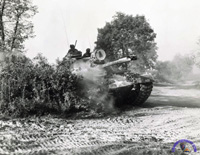
1. A Co M48A1 |
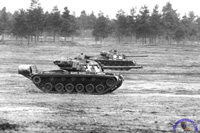
2. Tank platoon in the attack |
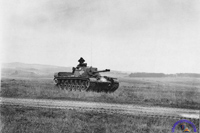
3. 1st MTB, 33rd Armor at Graf |
|
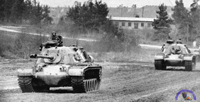
4. Real cold and lots of mud - it must be Graf |

5. A Co attacks an objective at Graf |
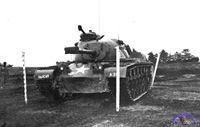
6. Best driver competition |
|
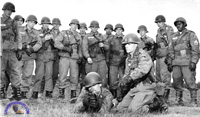
7. Winning platoon |
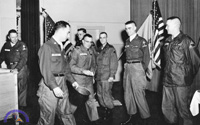
8. A Co attacks an objective at Graf |
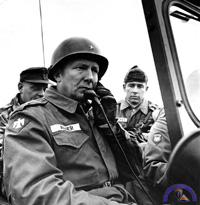
9. BG James Alger |
|
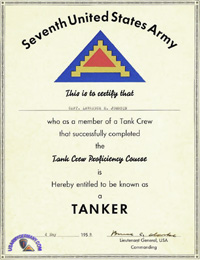
10. TCPC Certification |
|
|
|
| |
|
|
|
Tk Co, 16th Inf
Fuerth |
|
|
|
|
| |
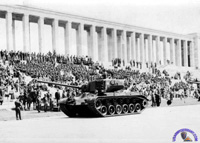
1. Soldiers Field, 1950 |
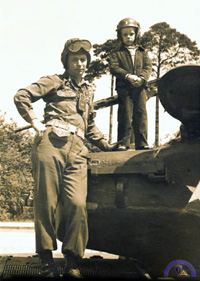
2. Lawrence Johnson and son, Hank, 1950 |
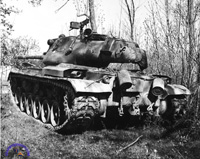
3. M-47, 1953 |
 |
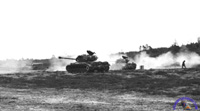
4. Indirect artillery fire, Graf, 1950 |
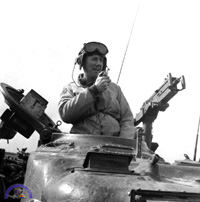
5. Pltn Leader, Tank Co |
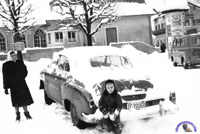
6. Garmisch, 1952 |
|
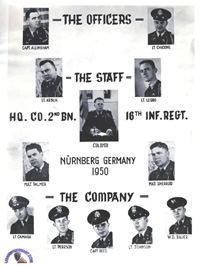
7. Company officers, 1950 |
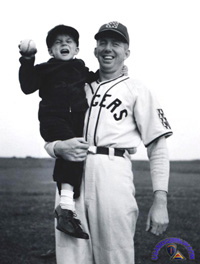
8. 16th Inf Regt baseball team, Soldiers Field, 1950 |
|
|
|
|
| |
| Combat Command "A" |
| |
| 1962 |
| (Source: SPEARHEAD, April 1962; STATION LIST 30 June 1962) |
| ORGANIZATION (April 1962): |
| |
UNIT |
|
STATION |
|
| |
Hq/Hqs Company |
|
Kirch-Göns |
|
| |
2nd MTB, 1st Cav |
|
Kirch-Göns |
|
| |
2nd MTB, 32nd Arm |
|
Kirch-Göns |
|
| |
Co B, 2nd HTB, 33rd Arm |
|
Kirch-Göns |
|
| |
2nd ARB, 36th Inf |
|
Kirch-Göns |
|
| |
3rd ARB, 36th Inf |
|
Kirch-Göns |
|
|
|
| |
| 1st BRIGADE |
| |
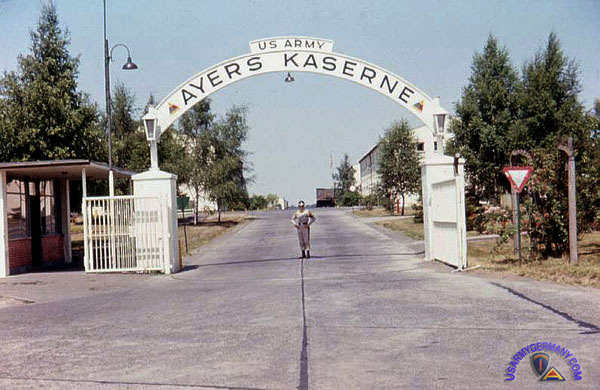 Entrance to Ayers Kaserne, 1964 (Kent Hoffman)
Entrance to Ayers Kaserne, 1964 (Kent Hoffman) |
| |
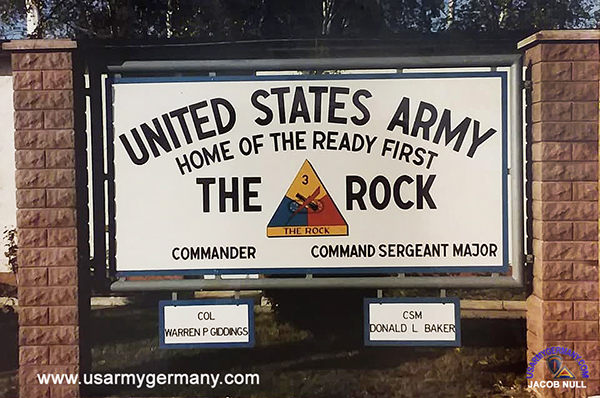 Sign at Ayers Kaserne entrance, around 1989 (Jacob Null)
Sign at Ayers Kaserne entrance, around 1989 (Jacob Null) |
| |
| 1963 |
| (Source: STATION LIST 31 July 1963) |
| ORGANIZATION (July 1963): |
| |
UNIT |
|
STATION |
|
| |
Hq/Hqs Company |
|
Kirch-Göns |
|
| |
2nd Bn, 32nd Arm |
|
Kirch-Göns |
|
| |
2nd Bn, 33rd Arm |
|
Kirch-Göns |
|
| |
3rd Bn, 33rd Arm |
|
Kirch-Göns |
|
| |
2nd Bn, 36th Inf |
|
Kirch-Göns |
|
| |
3rd Bn, 36th Inf |
|
Kirch-Göns |
|
|
|
| |
| 1980 |
| (Source: USAREUR Telephone Directory - Troop Units, Spring 1980) |
| ORGANIZATION (Spring 1980): |
| |
UNIT |
|
STATION |
|
| |
Hq/Hqs Company |
|
Kirch-Goens |
|
| |
2nd Bn, 36th Inf |
|
Kirch-Goens |
|
| |
3rd Bn, 36th Inf |
|
Kirch-Goens |
|
| |
2nd Bn, 32nd Arm |
|
Kirch-Goens |
|
| |
2nd Bn, 33rd Arm |
|
Kirch-Goens |
|
| |
3rd Bn, 33rd Arm |
|
Kirch-Goens |
|
|
 |
|
|
| Combat Command "B" / 2nd Brigade |
| |
| Combat Command "B" |
| |
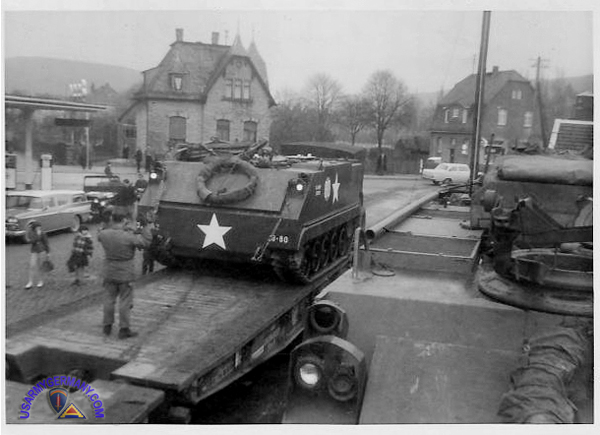
3/12th Cav tracks being loaded on flatbed rail cars at the Büdingen rail head, Feb 1961 |
| |
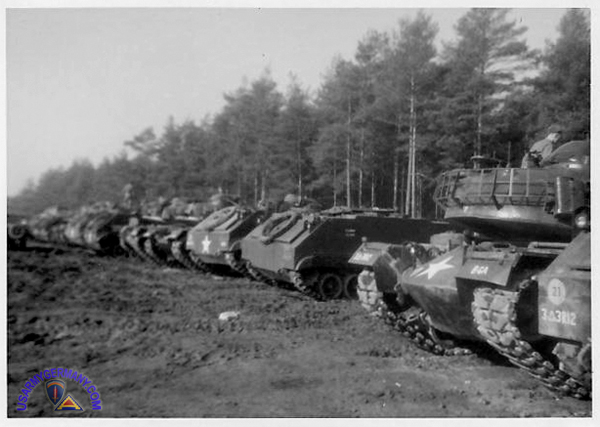
3/12th Cav track park at the Grafenwoehr Training Area, Feb 1961 |
| |
| 1962 |
| (Source: SPEARHEAD, April 1962) |
| ORGANIZATION (April 1962): |
| |
UNIT |
|
STATION |
|
| |
Hq/Hqs Company |
|
Gelnhausen |
|
| |
3rd Rcn Sq, 12th Cav |
|
Büdingen |
|
| |
1st MTB, 33rd Arm |
|
Gelnhausen |
|
| |
Co D, 2nd HTB, 33rd Arm |
|
Hanau |
|
| |
2nd ARB, 48th Inf |
|
Gelnhausen |
|
|
|
| |
| 2nd BRIGADE |
| |
| 1963 |
| (Source: STATION LIST 31 July 1963) |
| ORGANIZATION (July 1963): |
| |
UNIT |
|
STATION |
|
| |
Hq/Hqs Company |
|
Gelnhausen |
|
| |
1st Bn, 33rd Arm |
|
Gelnhausen |
|
| |
1st Bn, 48th Inf |
|
Gelnhausen |
|
| |
2nd Bn, 48th Inf |
|
Gelnhausen |
|
|
|
| |
| 1980 |
| (Source: USAREUR Telephone Directory - Troop Units, Spring 1980) |
| ORGANIZATION (Spring 1980): |
| |
UNIT |
|
STATION |
|
| |
Hq/Hqs Company |
|
Gelnhausen |
|
| |
1st Bn, 48th Inf |
|
Gelnhausen |
|
| |
2nd Bn, 48th Inf |
|
Gelnhausen |
|
| |
1st Bn, 33rd Arm |
|
Gelnhausen |
|
| |
3rd Sqdn, 12th Cav |
|
Buedingen |
|
|
 |
|
|
| Combat Command "C" / 3rd Brigade |
| |
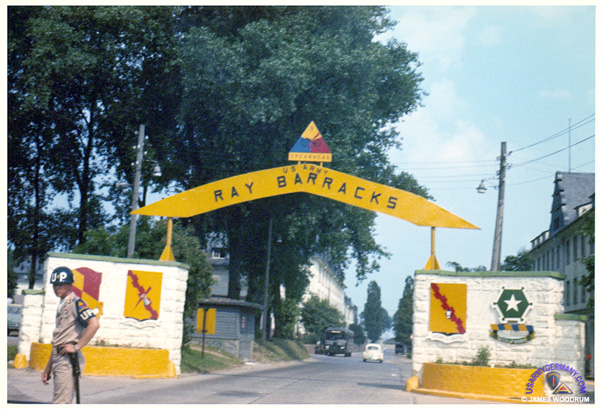
Main gate, Ray Barracks - home of 3rd Brigade (James Woodrum) |
| |
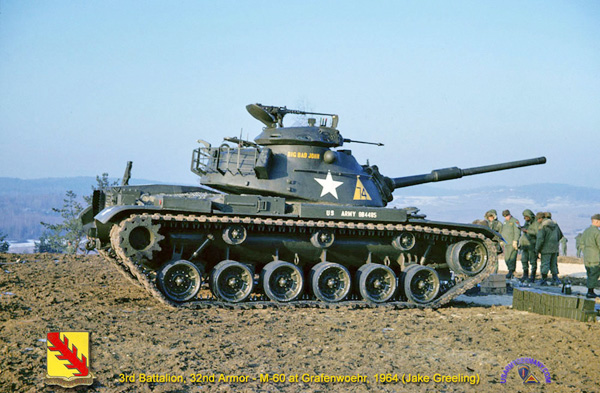
M-60 tank of 3rd Bn, 32nd Armor at Grafenwoehr, 1964 (Jake Greeling) |
| |
| Combat Command "C" |
| |
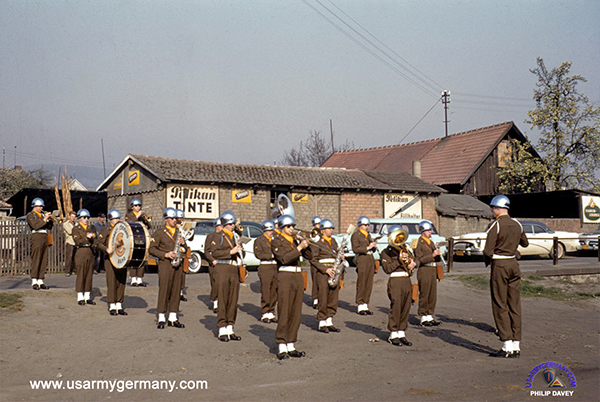
The CC "C" Band in Friedberg, mid-1950s (Philip Davey) |
| |
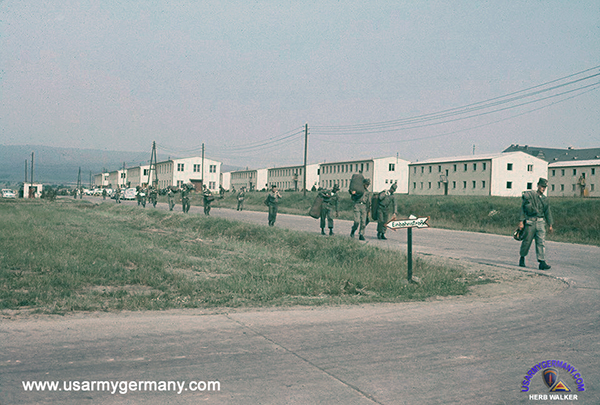 Cantonment area at Ray Barracks, Friedberg, late 1950s (Herb Walker)
Cantonment area at Ray Barracks, Friedberg, late 1950s (Herb Walker) |
| |
| 1962 |
| (Source: SPEARHEAD, April 1962) |
| ORGANIZATION (April 1962): |
| |
UNIT |
|
STATION |
|
| |
Hq/Hqs Company |
|
Friedberg |
|
| |
1st MTB, 32nd Arm |
|
Friedberg |
|
| |
1st ARB, 36th Inf |
|
Friedberg |
|
|
|
| |
| 3rd BRIGADE |
| |
| 1963 |
| (Source: STATION LIST 31 July 1963) |
| ORGANIZATION (July 1963): |
| |
UNIT |
|
STATION |
|
| |
Hq/Hqs Company |
|
Friedberg |
|
| |
1st Bn, 32nd Arm |
|
Friedberg |
|
| |
3rd Bn, 32nd Arm |
|
Friedberg |
|
| |
1st Bn, 36th Inf |
|
Friedberg |
|
|
|
| |
| 1980 |
| (Source: USAREUR Telephone Directory - Troop Units, Spring 1980) |
| ORGANIZATION (Spring 1980): |
| |
UNIT |
|
STATION |
|
| |
Hq/Hqs Company |
|
Friedberg |
|
| |
1st Bn, 36th Inf |
|
Friedberg |
|
| |
1st Bn, 32nd Arm |
|
Friedberg |
|
| |
3rd Bn, 32nd Arm |
|
Friedberg |
|
|
| |
| |
 |
|
|
| Combat Command / Brigade Units |
| |
1st Bn, 32nd Arm
3rd Bn, 32nd Arm
3rd Bn, 36th Inf
1st Bn, 48th Inf
2nd Bn, 48th Inf |
|
|
| 1st Battalion, 32nd Armor |
| |
|
| |
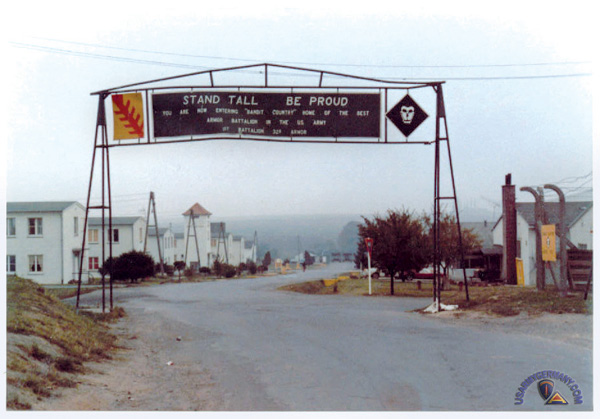
Entrance to battalion area on Ray Barracks (Gary Cool) |
| |
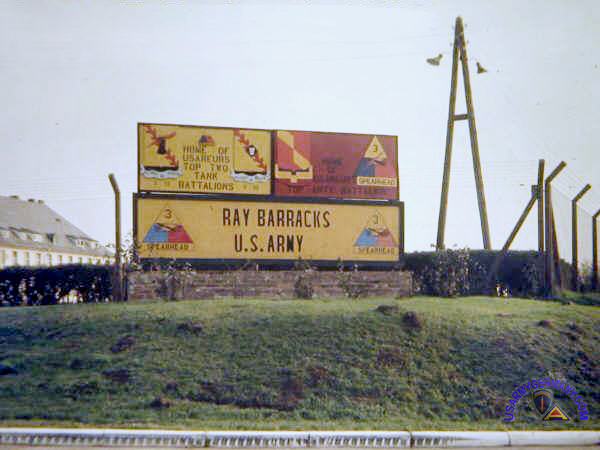
Entrance to Ray Barracks, 1973 (Gary Cool) |
| |
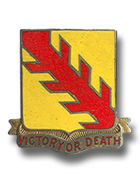 1st Battlion, 32nd Armor crest 1st Battlion, 32nd Armor crest |
| |
| (Source: Email from Gary Cool) |
| I have several personal photos I can submit from my time in 3rd AD (1971-74), C 1-32 Armor, Ray Barracks of personnel, equipment, etc. if you think they may be of use on your website. |
C Co, 1st Bn, 32nd Arm
Friedberg |
|
|
|
|
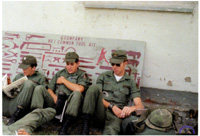
1. . |
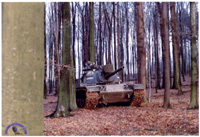
2. . |
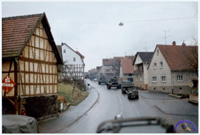
3. . |
|
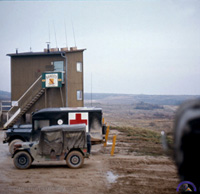
4. . |
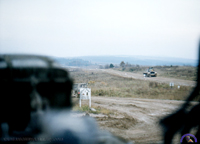
5. . |
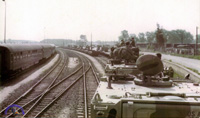
6. . |
|
|
| |
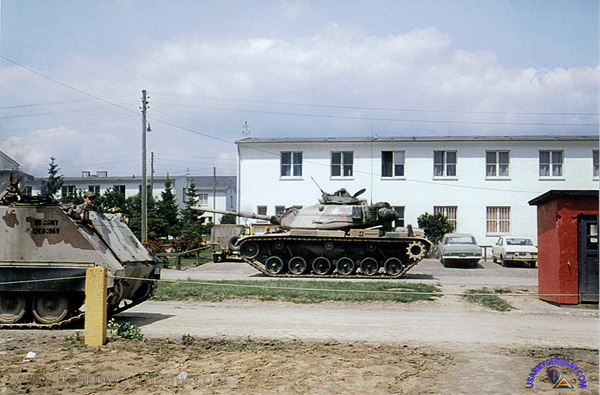
C Company barracks area (Gary Cool) |
|
|
| |
|
| |
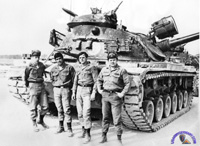
7. . |
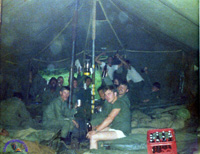
8. . |
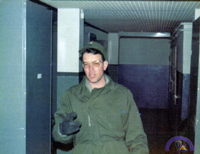
9. . |
|
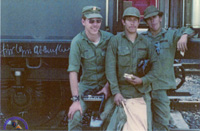
10. . |
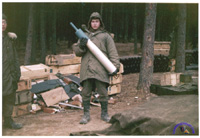
11. . |
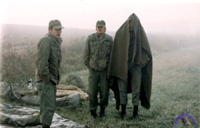
12. . |
|
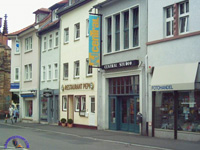
13. . |
|
|
|
|
 |
|
|
| 3rd Battalion, 32nd Armor |
| |
| Click here to view a unit history of the SCORPIONS (3rd Bn, 32nd Armd) - compiled by Jake Greeling (Format: Microsoft Word) |
| |
| (Source: Email from C. Jacob Greeling, Scout Pltn, Hq/Hq Co, 3rd Bn, 32nd Armd, 1963-66) |
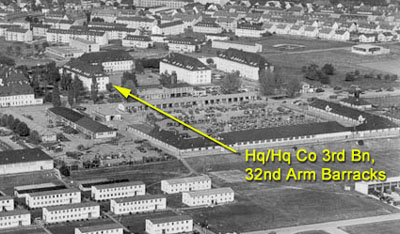 Ray Barracks, Friedberg
Ray Barracks, Friedberg |
|
I spent all my time in Friedberg at Ray Barracks. I was in HHC from Sept 1, of 1963 when the 3/32 was re-formed until I rotated home in 1966. I was first in the 4.2 Mortar Platoon but later I was moved to the Scout Platoon.
After I was seperated from the Army I went to work for the Railroad (Burlington Northern.) I am now retired but still do a little railroad consulting. Would be interested in hearing from anyone who was stationed there during 1963-66.
Photos below were taken during my tour of duty in the 3/32 Armored BN. |
|
Hq Co, 3rd Bn, 32nd Arm
Friedberg |
|
|
|
|
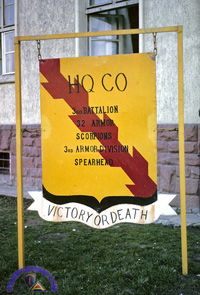
1. (KB) |
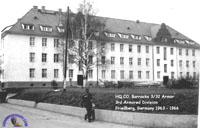
2. (KB) |
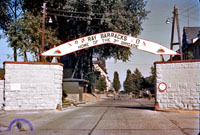
3. Main gate (KB) |
|
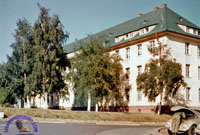
4. Hq/Hq Co Building (KB) |
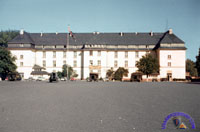
5. 3rd Bde Hqs Bldg (KB) |
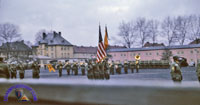
6. Color Guard (KB) |
|
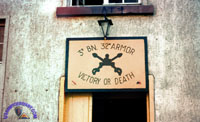
7. (KB) |
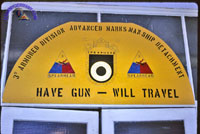
8. Marksmanship Det (KB) |
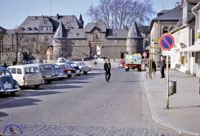
9. (KB) |
|
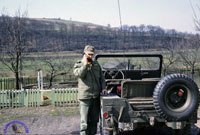
10. On a mission (KB) |
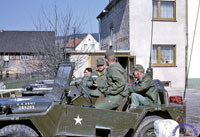
11. On a mission (KB) |
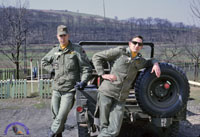
12. On a mission (KB) |
|
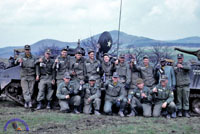
13. Scout Pltn, HHC (KB) |
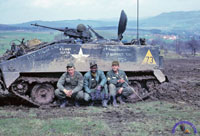
14. SCQC 1965 (KB) |
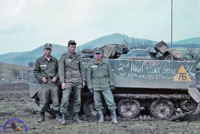
15. SCQC 1965 (KB) |
|
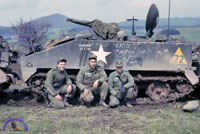
16. SCQC 1965 (KB) |
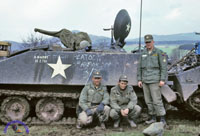
17. SCQC 1965 (KB) |
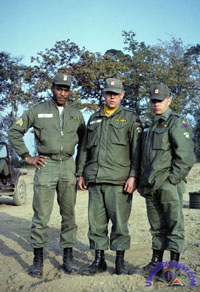
18. GSP members (KB) |
|
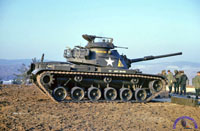
19. M-60 at Graf (KB) |
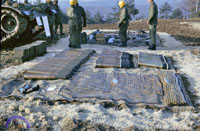
20. M-60 ammo display (KB) |

21. Live fire (KB) |
|
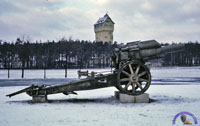
22. Grafenwoehr Training Area (KB) |
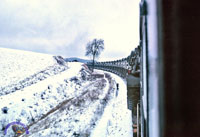
23. Train to Graf (KB) |
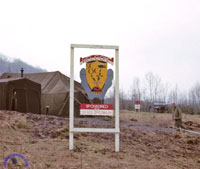
24. SCQC sige at Wildflecken (KB) |
|
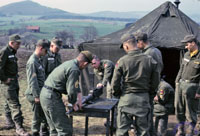
25. Training on the .50 Cal. (KB) |
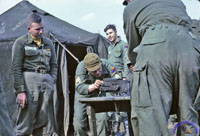
26. Lt Montgomery (KB) |
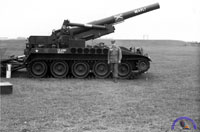
27. Greeling next to 8-inch How (KB) |
|
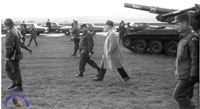
28. Secretary of the Army on a visit (KB) |
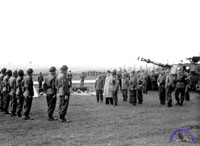
29. Secretary of the Army on a visit (KB) |
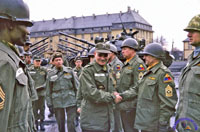
30. Div CG visits Ray Bks (KB) |
|
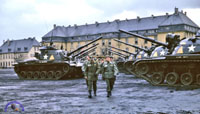
31. Div CG visits Ray Bks (KB)
|
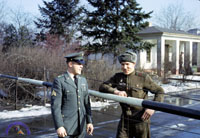
32. Berlin (KB) |
|
|
|
 |
|
|
| 3rd Battalion, 36th Infantry |
| |
| (Source: Email from John R. Marshall, 3-36th Inf) |
RE: 280mm battalions deployed to Germany:
There were only twenty 280mm Atomic Cannons manufactured. So five battalions of six guns each is wrong. Maybe planned, but not carried out.
RE: Davy Crockett Section
I was in the Davy Crockett Section of 3rd Battalion, 36th Infantry, 3rd Armored Division from February 1964 to June 1966. Here is a short history of my Section:
The Section was formed in March 1962 under Lt Joel Jones and SFC Claude Jullian. It had two squads. The first squad had an XM-29 Davy Crockett carried in an M-59 APC. The second squad had an XM-28 mounted on a jeep with a trailer modified to carry an M-388 Round. Plus they had a second jeep and trailer to carry the rest of the squad and gear.
In October 1962 the XM-28 and jeep were replaced with an XM-29 and M-59 APC.
In 1963 the 37mm Spotting Guns were added to the XM-29's and the M-59's were replaced with M-113 APC.
In 1964 the Davy Crockett Section was re-numbered from 901 and 902 to 97 and 98.
Also, we were assigned a Bunker at 3rd Armored Division Special Weapons Storage Site near Koeppern. We received PAL devises.
In late 1965 the Section was authorized to wear our own Davy Crockett TPI Qualified Patch on our field jackets.
In Spring of 1966 the Section two M-388 Atomic Rounds which were stored at the Koeppern Site.
The best I can tell, the Section was disbanded in ether late 1967 or early 1968. I am looking for eye-witnesses of the disbanding. |
|
 |
|
|
| 1st
Battalion, 48th Infantry |
| |
| (Source: Email
from Travis Sinnard, HHC 1/48th INF 3AD, 1987-1989; B Co 1/48 INF
& B Co 4/18 INF 3AD, 1989-1990) |
I was assigned to the 3AD Replacement Detachment (AEK02) APO 09039, from the 21st Replacement Detachment, at Rhein-Mein AFB on 31 May 1987.
On 1 June 1987, I was assigned to HHC 1/48 INF (AE7TO), APO 09091, at Coleman Kaserne, in Gelnhausen, Germany. I was assigned to the S-1 Section of HHC 1/48 as their M-60 gunner and M577A2 Track Driver from 1 June 1987 - 28 February 1989. Even though my MOS was 11B10, Infantryman, the S-1 NCOIC at the time liked to utilize Infantryman within his shop as he could use them not only as clerical staff, but also they had they advantage of Infantry training that was a benefit to the S-1 shop during ARTEP's, Reforger, etc. Working within HHC and the "S Shops" really let me get a behind the scenes view of all that really has to transpire in order for a unit to function.
In 1988, 1/48 INF went into NET (New Equipment Training) at Vilseck, Germany, with follow-on gunnery at Grafenwohr and Hohenfels (Grafenwohr and Hohenfels were like a second home to us all - I think I spent more time there than in Garrison), for the Bradley Infantry Fighting Vehicle, to replace the M113 APC. On completion of NET, we were awarded the MOS 11M10, and kept 11B10 as a "secondary."
1988 was also my first and only year to experience Reforger. Working with our NATO allies in this exercise was an experience I will never forget. 1988 was a year of transition for 1/48 INF, and also marked our transition from the Jeep to the HMMWV.
On 1 March 1989, I was transferred to a line company, B Co 1/48 INF, at my request, and with the endorsement of the Battalion Commander, LtCol Robert J. StOnge, so I could spend my last 11 months utilizing the Infantry skills I had strived so hard to acquire at Fort Benning, GA. While assigned to B Co 1/48 INF I started as a M-249 SAW gunner, progressed to Platoon RTO, and finally to a dismounted Fire Team Leader for a very short time.
The 1st Plt "Bandits" of 1/48 and later 4/18 were just exceptional human beings and soldiers as well. Here is just a partial list of some of the finest people I have ever met: SFC John Santiago, Plt Sgt (Definitely a "soldiers soldier and a great influence on me); SSG George Leonty (SSG Leonty could always keep us laughing, even in the worst circumstances), SSG Cabanilla, Sgt Patrick Bridwell, SPC Lance Countryman, PFC Michael Patterson, SSG Samuel Miller, SGT Mateo, and SPC Joseph Nabb. There are a few more guys, but my memory is kind of fuzzy on the other names.
In June of 1989, 1/48 INF was re-designated 4/18 INF Regiment. This was a morale killer for all us, due to the rich history of the 1/48 INF. In January 1990, I opted to ETS rather than revert back to being an 11B10 at the request of the DA and accept my next assignment to Panama, or Korea. This was probably a large mistake in hindsight as I miss the Army on a daily basis, not to mention all my fellow "Bandits" from 1st Plt B Co 1/48 - 4/18, but I was tired from spending almost 3 years overseas and had wanted to go back to Fort Benning, GA. to possibly try and get into Airborne and DA and the Brigade Reenlistment NCO said that wasn't going to happen!
On 28 January 1990, I departed Gelnhausen, Germany and returned to out process from the Army at Fort Jackson, SC on 31 January 1990, after 2 years, 11 months and 28 days of active duty.
Travis Sinnard |
|
 |
|
|
| 2nd
Battalion, 48th Infantry |
| |
| (Source: SPEARHEAD,
Aug 23, 1983) |
Part of Division 86 Reorganization
Delta Company arrives
By Rich St. Denis
July 29, 1983, has become a significant date in the rich and proud history of the 1st Battalion, 36th Infantry. It marks the day that the "Spartan" battalion officially received the men and equipment for its new rifle company - "Delta Company" - as authorized by Division 86.
For the 3rd Brigade headquarters, the date is also memorable for it signifies the arrival of the brigade's new Scout Platoon.
On the 29th, 126 men in their 33 wheeled and tracked vehicles departed Coleman Barracks in Gelnhausen for the two-hour road march to Friedberg. That convoy marked their transfer from the 2nd Bn, 48th Inf to the 3rd Brigade and the 1st Bn, 36th Inf. The move constituted a permanent change of station (PCS) for the soldiers and an important step for the Spearhead Division in its extensive restructuring process as part of Divison 86 and Force Modernization.
On hand to greet the new "Spartans" were their comrades who formed a cordon from the back gate of Ray Barracks to the motor pool. Once there, the soldiers were met by their platoon sponsors who helped haul their baggage and personal gear to the new living quarters. That afternoon the battalion conducted a welcome picnic to cap off the eventful day.
The whole procedure for the "lateral transfer" of a rifle company from one battalion to the next was by no means an easy chore. Said battalion commander, Lt. Col. Harvey Watson of the 1-36th Inf. "There's turmoil of course, but we're working through it well."
A few weeks earlier, the 1st Bn, 48th Inf in Gelnhausen received its new "Delta Company." Over 100 soldiers and their equipment from the 2nd Bn, 48th Inf were laterally transferred to their sister "Dragoon" battalion, the 1st Bn, 48th Inf.
Soon another move is planned. More soldiers from Gelnhausen are due to move to Kirchgoens to become the nucleus for the new "Delta Companies" in the 2nd and 3rd Battalions of the 36th Infantry. Likewise, elements of the First Brigade's Scout Platoon will be coming from the 2nd Bn, 48th Inf. On October 15, the 2nd Bn, 48th Inf will be inactivated.
Under the Division 86 plan, there will be four mechanized infantry battalions in each of the Army's combat heavy divisions. Each battalion will consist of four rifle companies, an anti-armor company and a headquarters company.
In Division 86, the number of tank battalions will remain at six, but they too will receive an extra line company. In both the mechanized infantry and armor battalions the combat support companies will be dissolved, and their functions will be taken up by the headquarters companies.
Throughout the Spearhead Divison, tank and mechanize infantry battalions have been intensively preparing for this reorganization. The modernization effort will continue for several years in another respect as over 400 items of new equipment are introduced into the Army's inventory. |
|
|
| |
| (Source: Email from Robert Briggs) |
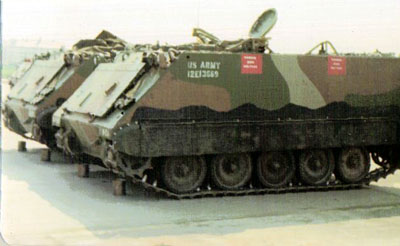 My ride -- B-24 M-113-A1, B 2-48 Command Track
My ride -- B-24 M-113-A1, B 2-48 Command Track |
|
I was in 1st Squad, 2nd Platoon, Company B, 2nd Bn, 48th Inf, 1972-1976.
SGT Robert Briggs, Oct 1975
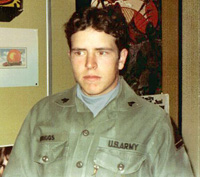 |
|
Co B, 2nd Bn, 48th Inf
Gelnhausen |
|
|
|
|
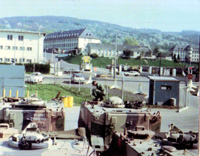 1. The Kaserne, Sgt Rickel B 2-48, Track Park (KB) 1. The Kaserne, Sgt Rickel B 2-48, Track Park (KB) |
 2. Shooting the breeze at the track park (KB) 2. Shooting the breeze at the track park (KB) |
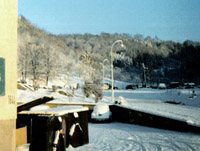 3. Top of the Hill under snow, 1975 B 2-48 (KB) 3. Top of the Hill under snow, 1975 B 2-48 (KB) |
|
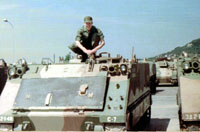 4. Sgt Mowens, C 2-48 on C-7 APC M-113A1 (KB) 4. Sgt Mowens, C 2-48 on C-7 APC M-113A1 (KB) |
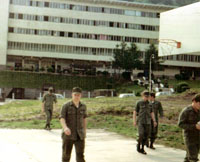 5. On the Hill B 2-48 (KB) 5. On the Hill B 2-48 (KB) |
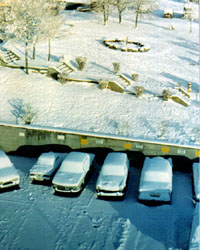 6. Coleman Barracks, Winter 1974 (KB) 6. Coleman Barracks, Winter 1974 (KB) |
|
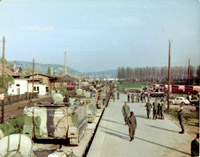 7. Gelnhausen railhead - next stop: Graf (KB) 7. Gelnhausen railhead - next stop: Graf (KB) |
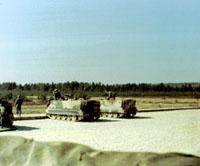 8. Graf 50 cal Range 1974 (KB) 8. Graf 50 cal Range 1974 (KB) |
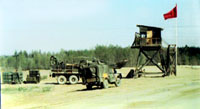 9.
Cobra Range, 3-12 ARC, Graf 1975 (KB) 9.
Cobra Range, 3-12 ARC, Graf 1975 (KB) |
|
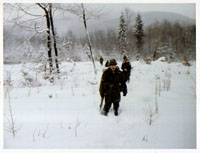 10. 1st Squad, 2nd Pltn, on patrol at Wildflecken, 1974 (KB) 10. 1st Squad, 2nd Pltn, on patrol at Wildflecken, 1974 (KB) |
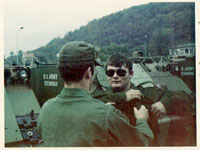 11. Capt Strothers - contraband search 1975 (KB) 11. Capt Strothers - contraband search 1975 (KB) |
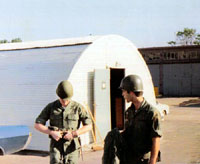 12. Guard Duty SP-4 Danials 74 B 2-48 (KB) 12. Guard Duty SP-4 Danials 74 B 2-48 (KB) |
|
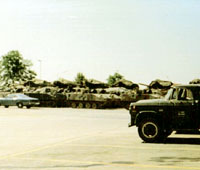 13. Recon Plt HQ 2-48 & 1-33 Armor 1974 (KB) 13. Recon Plt HQ 2-48 & 1-33 Armor 1974 (KB) |
|
|
|
|
|
| |
| (Source: SPEARHEAD,
Nov 1, 1983) |
2nd Bn, 48th
Inf inactivated
GELNHAUSEN - The "Dragoons" of the 2nd Bn., 48th Inf were inactivated
October 16 at Coleman Kaserne here after 26 years of service in the
3rd Armored Division. |
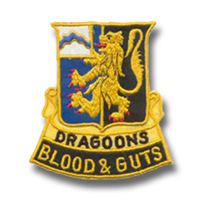 48th
Infantry
48th
Infantry
Pocket Patch |
|
In a formal ceremony at Coleman Kaserne on Friday, Oct 14, the
mechanized infantry battalion from the division's "Iron Brigade"
retired its colors.
The inactivation came as part of the Division 86 plan to reorganize the 3rd Arm Div's combat
power.
During the past few months, soldiers of the 2nd Bn, 48th Inf.
have been transferred to other mechanized infantry units within
the Spearhead Division, namely the 1st, 2nd and 3rd battalions
of the 36th Infantry and to the 1st Bn, 48th Infantry. The former
2-48 Inf. companies have become the "Delta" Companies in their
new battalions.
According to Lt. Col. Donald Conrad, commander of the 2-48 Inf,
the inactivation was a disappointment to the "Dragoons." "It's
hard for the soldiers to leave a unit that they have been part
of for so long," he explained. |
|
Organized in May of 1917 in Syracuse, New York, as Company B, 48th Infantry in the 20th Infantry Division, the unit activated in 1921 at Camp Travis, Texas.
Reconstituted in 1942 again as Company B, 48th Armored Infantry in the 7th Armored Division and then redesignated as the 38th Armored Infantry, it served in World War II in Northern France, Rhineland, Ardennes-Alsace, and Central European campaigns. It earned the Presidential Unit Citation at St. Vith, as well as a Belgian Forragere.
After the war the unit was inactivated at Camp Shanks, New York, then reactivated at Camp Roberts, California. In October 1957, it was redesignated the 2nd Armored Rifle Battalion, 48th Infantry, assigned to the 3rd Armored Division, and activated in West Germany. In 1963, it was reorganized and redesignated as the 2nd Bn, 48th Infantry. |
|
 |
|
|
| 2nd Battalion, 73rd Field Artillery |
| |
| (Source: Email from Marvin Meyerhoffer) |
I noticed in one item on the Honest John section of the Overview Page, Field Arty (1950's-60's), that the writer stated that the 762mm Honest John was "guided." You probably know as well as I do that it was not.
For awhile the 2nd FA Bn, 73rd Arty had three heavy weapons: the 155mm SP, the beautiful goliath - the 8-inch SP, and the 762mm. Boy, did we have some artillery, and some great artillerymen!
I was a transit operator for the first firing mission by the 3rd Armored Division at Graf. in 1958. As I recall, we came within approximately 25 meters of the old German bunker we were firing at. Not bad for a first try. One humorous note about this mission, the electric firing device malfunctioned, and the rocket was launched by bringing lead wires in contact with the terminals on the battery commander's jeep.
I also remember being taken with about 25 other Spearheader's to a mysterious destination (the canvas flap on the back of the deuce & a half was pulled down, and an officer was positioned to prevent anyone looking out), where we picked up atomic components. Also, the "atomic room" of the 73rd Field Arty. was guarded 24/7. |
|
| |
| (Source: 3rd Armored Division, Yearbook 1958, Germany) |
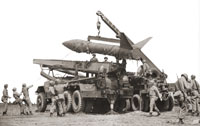 2nd FA Bn (Rkt/How), 73rd Arty
2nd FA Bn (Rkt/How), 73rd Arty |
|
Under the ROCAD reorganization, the 2nd Field Artillery Battalion (Rocket/Howitzer), 73rd Artillery became an organic unit of the 3rd Armd Div.
The unit was awarded the 3rd Armd Div Association Plaque for the Best Artillery Battalion of the training year July 1, 1956 to June 30, 1957.
All three firing batteries rated "Excellent" on their 1957 battery tests and received the highest scores of Div Arty.
In Jan 1958, Battery D fired the Honest John rocket at Grafenwoehr with 100 percent accuracy. |
|
| |
CORRECTION
(Source: Email from George D. Brown, Jr.) |
I visited your website recently and noticed that there were responses/emails or letters from former members of DivArty, 3AD. There was an email cited from Marvin Meyerhoffer of the 2nd FA Bn, 73rd Arty re his experiences with that unit. Beneath it and cited as from the 3rd AD, Yearbook 1958 Germany was the information noting the assignment of that Battalion to the 3AD. More important was the further information that "The unit was awarded the 3rd Armd Div Association Plaque for the Best Artillery Battalion of the training year July 1, 1956 to June 30, 1957 and received the highest scores of Div Arty." I have recently received a copy of the page from which this information was taken and it is correctly cited. It is, however, in error.
Actually the 2nd FA Bn, 73rd Artillery did not come into existence in the 3rdAD until 1 Oct 1957. The unit that it replaced and "descended" from was the 509th AFA, the only medium artillery unit in the 3rd AD during that training year 7/56 to 6/57. According to the C Btry FDC Chief of Section from June 1957, John von Seeburg, and my own experience with them, they took no Battery Test in the first half of 1957. The only Battery Tests taken by the 509th AFA Bn during its time in West Germany were at Grafenwohr in August 1956. Charley Btry received the highest score, 96.58%, in the Battalion and in Northern Area Command. 1LT Harold C Towle received the high score trophy from the Battalion CO sometime after May 1956.
I was one of the one hundred plus original recruits, draftees and enlistees, who joined C Btry, 509th AFA Bn in August 1955. We took Basic and Advanced Training together in the unit and in May 1956 shipped to Pioneer Kaserne, Hanau, West Germany. We draftees returned home in May 1957 and the enlistees stayed for another year. I ran the FDC from 16 Oct 1955 until we left in May 1957. Now, more than 50 years later, I am writing a memoir of those days with stories and comments from more than 45 of my Battery-mates and three officers still living.
I realize that the account of the 3rd AD Association Plaque may well be to the 2nd FA Bn for convenience, given that the 509th AFA Bn had been retired and the 2nd FA Bn was its descendant unit, but it does a disservice to the members of the 509th AFA Bn who had left for home to not get credit for their accomplishment. |
|
|
|
| 1963 |
| (Source: Email from Jon A. Wiant) |
Wandering around the internet this afternoon I came across the 3rd Armored Division (Spearhead) site and it brought back great memories of my time with the 2d/73rd Field Artillery (Honest John) April 1963 to June 1965.
Originally assigned to Battery D, 2nd Rocket/Howitzer Battalion, 73rd Artillery, I went through the ROCAD in the Fall of 1963 when the battalion was separated into two battalions, the 6/40th which retained the tube artillery and the new 2nd/73rd. Overnight Delta Battery became the new battalion and we went from one of the largest battalions in the Army structure to a battalion with a TOE of 283 as I recall. And shortly thereafter we received a grizzled old LTC as our new battalion commander, John W. Vessey Jr.
I had the great honor and delight to serve with LTC Vessey for the next two years as part of his consolidated S2/S3. In the first year he promoted me from PFC to E4 and then E5 and I was his Assistant S2 Sergeant. My time with him was a daily laboratory in leadership.
In 1965 I left the battalion for training in "area intelligence" at Fort Holabird, a career change that would eventually bring me into senior intelligence leadership position with Department of State, DOD, CIA and the White House where I served as Director of Intelligence Policy.
LTC Vessey had a fine goodbye party for me as I left Fliegerhorst Kaserne and at my send off gave me the 3rd Armored Division (Spearhead) Certificate of Achievement. It remains a most treasured tribute.
I was later to meet Vessey when he was Chairman of the Joint Chiefs of Staff and I was Deputy Assistant Secretary of State for Intelligence. It was a fine reunion and we both concluded that we had done much better than either of us expected.
I have some neat pictures of the battalion in the field in those pre-Vietnam years when we worried most about our ability to stop the Soviets at the Fulda Gap.
ADDITIONAL INFORMATION
I will share another memory that just flitted by. 2/73d Field Artillery was one of the 3rd Armored units selected to march in review for President Kennedy during his June 1963 Germany visit. I recall that somewhere up the chain, a decision was made that we looked far better wearing our AG 108 wool shirts and battle pants than we did in regular fatigues. The parade was set for 1000 on the Fliegerhorst runway. Each subordinate command added another 15 or 30 minutes to the time we were to report for the parade. WE assembled at Pioneer Kaserne at 0530, road marched cross country the 4-5 kilometers to Fliegerhorst Kaserne. It was a very hot day, perhaps 95 degrees, and we stood in formation for three hours before the parade began. Soldiers were dropping right and left and the medics were running around with ammonia ampules to awake the fallen comrades.
Nothing, however, could make this a more surreal event then what happened next. Fierce warriors, battle ready, M-60 tank engines rumbling and as the command "Forward, March!" cascades down through the subordinate units, the 3rd Armored Division Band leads off with "Moon River" from "Breakfast at Tiffanys", set to a dreamy 4/4 time. |
|
|
| |
| 1974 |
Have seen some comments indicating that 2nd Bn, 73rd Arty (HJ), still stationed at Francois Kaserne in 1973/74, was the last HONEST JOHN unit in the US Army and that the unit was inactivated sometime in the Spring of 1974.
Can anyone confirm this or have additional information on the last service years of this unit? |
 |
|
| |
Related Links:
The
Tanker - A wonderful photo collection with narrative of various
exercises in Germany involving the 3rd Armored Division in the 1970s.
Norm Gregory's Flickr Page - more photos of Fliegerhorst Kaserne and 2nd Bn, 73rd Arty
|
| |
| |
|










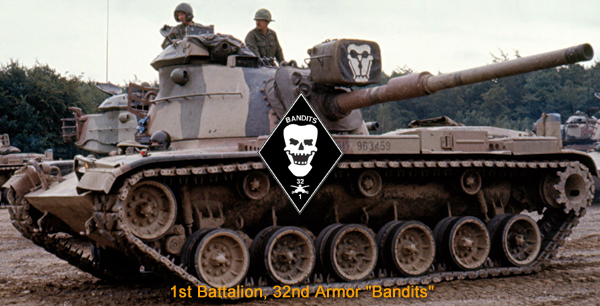


 1st Battlion, 32nd Armor crest
1st Battlion, 32nd Armor crest 